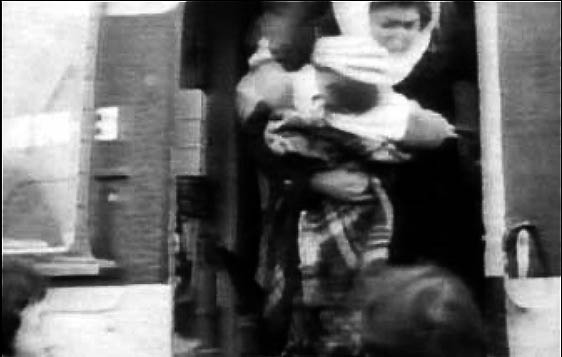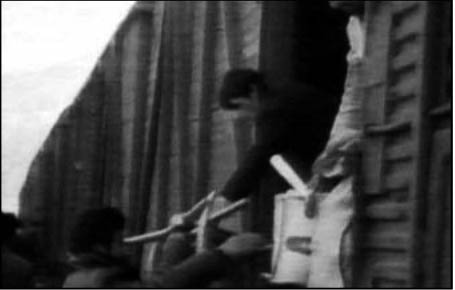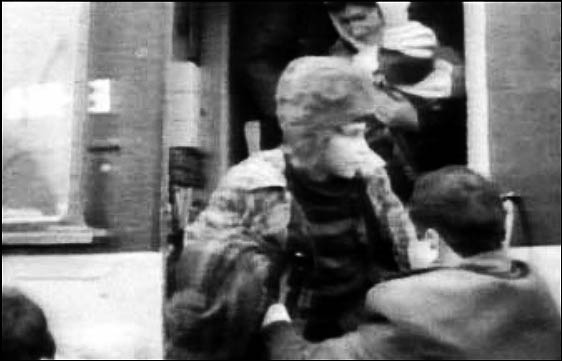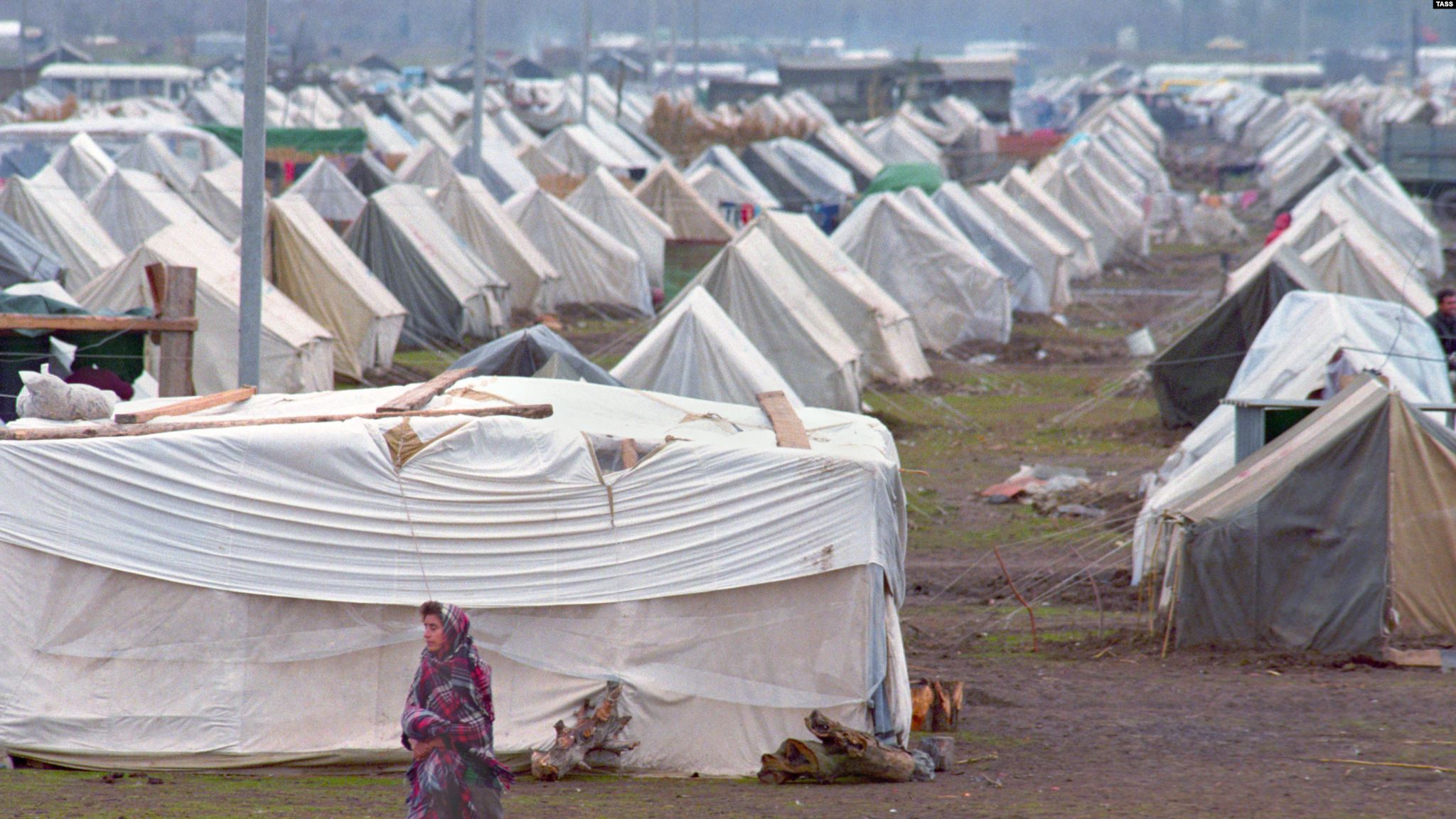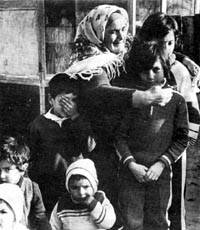The Azeri pogroms, which resulted in the complete «cleansing» of Armenia from the Azeri minority, became the prelude for the Karabakh conflict.
The first ideologists of the far-fetched Karabakh problem, which brought to the emergence of refugees in 1988-1989 the number of which was not defined more precisely yet despite 10 years passed, was the representatives of the older generation: Yakov Zarobyan (ex-first secretary of the Central Committee of the Communist Party [CC CP] of Armenia), Ovanes Bagdasaryan (ex-second secretary of the CC CP of Armenia), Viktor Ambartsumyan (president of the Academy of Sciences of the Armenian SSR), Sero Khandzadyan, John Kirakosyan, Aramayis Mnatsakanyan, B. Balumyan, Avanes Shiraz (husband of Silva Kaputikyan, notoriously known Armenian writer) and others. They founded the pan-Armenian movement aimed at seizure of Anatolia from Turkey and Mountainous Karabakh and Nakhichevan from Azerbaijan. Silva Kaputikyan, who made two peoples enemies with her writings, Zoriy Balayan, the culprit of bloodshed of hundreds of people, who, moreover, was the delegate in the Supreme Soviet of the USSR from Azerbaijan and who hasn’t taken the punishment for his deeds up to date and also pogosyans, manucharyans, dadamanyans, who joined to them were the ones who further assisted further escalation of the conflict. Let’s pay attention to Zoriy Balayan’s speech in the cession of the Supreme Soviet of Armenia. This speech can be a graphic example of his political intrigue: «In order to prevent the repetition of the Karabakh tragedy, we should immediately begin a judicial process under the aegis of the Supreme Soviet USSR against the organizers of the genocide of the Armenians and Russians (-?!) in Nakhichevan Autonomous Republic».[35] Such a slander doesn’t need comments.
One important question emerges. Was it possible to prevent the Karabakh conflict, this wave of refugees? Yes, it was. If Moscow took the legal position from the beginning having abolished from the first day the illegal decision of the Regional Soviet of the MKAR on the incorporation into Armenia there would be no lawlessness, no bloodshed, and people wouldn’t leave native hearths. The culprits of this bloodshed is Armenian leadership, as well as the Central government which patronized them, and also the Azeri government which didn’t understand the substance of the events and couldn’t evaluate properly the situation. Mass media, which was under the influence of the Armenian lobby, also have played an overall negative role in aggravating the interethnic relations due to its mistakes, one-sided position, and subjectivity when lighting the events.
The rumours about the creation of an Armenian republic in Mountainous Karabakh and incorporation of adjacent Shaumian region to it based on the illegitimate decision of the regional soviet of the MKAR without participation of the Karabakh Azeri delegates appeared in the cover pages of all the central newspapers – «Pravda», «Izvestiya», «Komsomolskaya Pravda» etc. In the meantime, the legitimate Decree of the Supreme Soviet of the Azerbaijan SSR saying that this decision counteracts the Constitution of Azerbaijan and the USSR was not lighted up.
While the Armenian and the central media are responsible for inciting the interethnic hostility, the Azeri media of that time is responsible for criminal silence (by order of the authorities) during the pogroms. Neither Azeri media nor the central one didn’t inform about the murder of two Azeri youth, which triggered the pogroms. But after the Armenian nationalists incited the Sumgayit events, for two years the Armenian and a number of central press agencies did their best to introduce the Azeri people to the international community as bloodthirsty savages. For killings of 26 Armenians in Sumgayit (6 Azeris were murdered during the clashes as well) 96 people were sentenced to death, but not only the world community but also many in Azerbaijan itself don’t know about the massacre of 317 Azeris in Armenia during 1988-1989: what criteria of justice does this fit in? It becomes clear from the Office of the Public Prosecutor of the USSR response to the Chairman of the Supreme Soviet of the Republic of Azerbaijan, that the investigation of the Azeri pogroms in Armenia were entrusted not to the Office of Prosecutor of the USSR, as it was during the Sumgayit events, but to that of the Republic of Armenia.
How one can justify that more than 200 criminal cases from 530 being in the consideration in the Armenian courts were closed due to the «lack of criminal compound»? In the meantime, it is known, that only 53 criminal cases on 93 defendants were sent to the Armenian courts during the period of pogroms. Of these crimes committed on national basis 48 cases were considered, 82 people convicted. From these people convicted only 30 were sentenced to various periods of imprisonment. Pay attention to the «just» sentence of the Armenian courts: only 30 people were brought to responsibility for brutal murder of 317 people, and got rid off with several years of imprisonment.
The article «Pogroms in Armenia in 1988-1989» by Arif Yunus, which was the result of big research work and which was published in the «Express-kronika» newspaper[36] to familiarize the international community with Armenian brutalities against Azeris in Armenia can be a valuable source as well. We are giving extracts from this article.
What can we see from the materials we have? Most part of the Azeris killed in Armenia (186 people or app. 87%) was killed during the first year of the Karabakh conflict in 1988. Next year this list was reinforced with more 28 people and one young man who being very incautious came in 1990 to his native village in the Vardenis region to learn about the fate of his family and beaten to death. Especially many killed among the village population (188 people-88%, the number of urban people killed is 26 or 12%). Pogroms took place in 19 regions of Armenia but most of the killed and died was in the Vardenis region. (If to believe an article in the «Golos Armenii» newspaper then the Armenian population of this very region took tender care of the moving Azeris).
Among 11 towns the «leader» is Masis – 8 people killed, Kalinino – 5, Yerevan – 4, Kajaran – 2, Kirovakan, Kafan, Gorus, Sisian, Spitak, Amasiya, and Alaverdi – 1 per each.
Materials show that at least 127 people were murdered. Many of them were beaten to death (50 people), another 35 people, including 7 children and 10 old, died as a result of tortures, 15 (other reports say 11) people were burned alive, among them 9-year old girl living in Ghukark Z.N. Nabiyeva and 78-year old woman G.M. Aliyeva. Also 15 people were (including 2 children and 6 old) shot, 7 people were run over by cars, 3 people were drowned, 1 man was killed by electricity and at last 19 y.o. B.I. Akverdiyev who lived in the Amasya region was hanged.
The second largest group comprises overall 65 people. Those are the people who died because of heart attack, as a result of nervous breakdown (10 people), because of negligence or crime of the Armenian doctors in the hospitals (16 people) and because of freezing to death in the mountainous passes during banishment from Armenia (49 people).
And at last, two people committed suicide not bearing the insults, «accidents» were organized for 22 people and fate of 8 people is still unknown.
The majority of those who died are adults (from 21 to 59 y.o.) and they comprise 109 people. Of them 24 are women, and 85 are men. Old men i.e. people older than 60 y.o number 77 people. Of them 22 are women, 55 are men. The oldest one among them is beaten to death 89 y.o V.S. Shikiyev (from the village Yukhari Kerpulu of the Noyemberyan region). Children (aging from 2 months baby to 14 years old adolescents from the village of Shirazly of the Ararat region) number 19 people. Of them 10 are girls and 9 are boys. The number of youth aging from 15 to 20 y.o is relatively low. Of them one is girl and 7 guys.
It’s hard to imagine the brutalities committed by Armenians in Ghukark. Only from end-November to early December 1988 70 Azeris were murdered here. Of them 21 people (including 6 women and 3 children) were killed in the village of Kezaldere, 17- in the village of Vartana.
How did the pogroms and violence carried out?
The perception that banishment of Azeris from Armenia began after the Sumgayit events and moreover 8 months after it is not true.
On January 25, and on February 18 and 23 1988 first group of Azeri refugees numbering 4 thousand people came to Azerbaijan. Most of them settled in Sumgayit suburbs. Since, it was a «vague period» of the conflict at that time the tactics against Azeris was corresponding to it- threats, intimidations, beatings, blackmail. But this hasn’t reached to a mass level yet, that’s why the number was not so high. Immediately after the Sumgayit events the situation changed drastically. After March 10 four Azeris inhabitants of the village of Mehmandar south to Yerevan were killed. Police tried to convince their relatives that it was an accident. On March 25 direct assaults to the Azeri villages of Vedi, Shirazly, Khalsa and Shidly in the Ararat region took place with help of firearms. One man was killed, tens of people- wounded, more than 100 houses burned. On May 11, 18, 23 next assaults were carried out against the other villages situated near Yerevan. The population of the village Shirazly (880 people) couldn’t bear it and moved to the Soviet-Turkish border and had to live in the open air on the bank of the Araz River for four months. On June 20 the population of five more Azeri villages (app. 10 thousand people) joined them.
It also should be noted that not only regional leaders, but also some responsible employees of republican scale, and particularly, ex-first deputy chairman of the Soviet of the Ministers of Armenia S. Arutyunyan were responsible for organizing the assaults to these villages.
Certainly, all of these were not an accident, but well-planned and organized actions. There are all grounds to claim that the «hooligans» movement was controlled by the Armenian government and was under protection of the «Karabakh» committee.
For example, don’t you think that speech of the correspondent member of the Armenian Academy of Sciences R. Kazaryan in the meeting in Yerevan on November 4 1988 gives evidence to this? He said in his speech: «First time during these decades we have opportunity to cleanse (!?) Yerevan. I consider this the greatest achievement of our ten months struggle»37.
In March 1989 a statue was erected in Kafan to the fervent enemy of the Azeri people Nzhde, who committed atrocities against the Azeri population of Sharur-Daralegez in 1918. First secretary of the raikom (regional committee) Mkrtchyan said these words on the opening of the statue while discussing the realization of a century-long dream of dashnaks: «You [meaning Nzhde along with other dashnaks] toiled a lot, but couldn’t cleanse the country from Azeris. Your grandchildren made your big dream come true for yourselves.» Today there is left no single Azeri living in Armenia. But, it’s true, when Mkrtchyan gave the speech above there was only one Azeri village left. This was the village of Nuvadi and its population was also expelled as previous 200,000 people in one single day on August 8 1992.
The Armenian press also ignored the fact that more than 20 thousand Kurds and many Russians left Armenia as well. It is also unknown how many thousands of Azeris died of nervous breakdown as a result of all the tortures, sorrow and troubles they witnessed living a refugee life.
That’s how the banishment of Azeris from Armenia and consequently from 20% of Azerbaijan itself was accomplished, without stir and din, by means of certain methods well known to the Armenian nationalists. Hearths of thousands and thousands of Azeri families were extinguished.
Source: «Historical geography of the Western Azerbaijan» Baku 1998 (In Russian) Chapter “The horros of last invansion”
